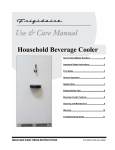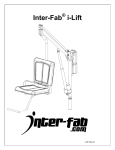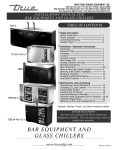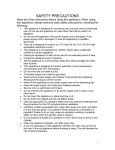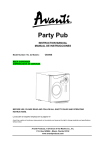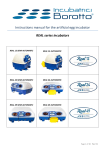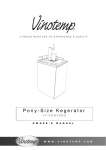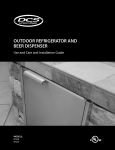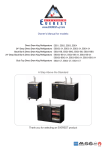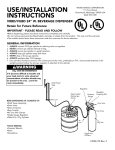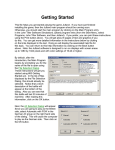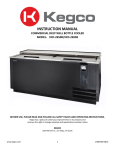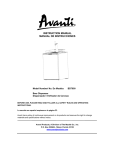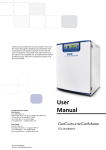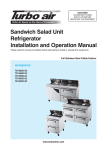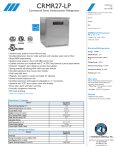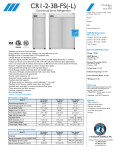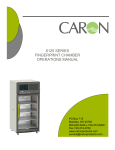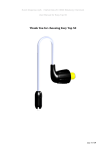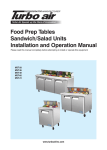Download User Manual - WebstaurantStore.com
Transcript
User Manual Beer Dispenser User’s Manual UDD1, UDD1S, UDD2448, UDD2448S, UDD2460, UDD2460S, UDD2472, UDD2472S 07/2015 Please read the manual thoroughly prior to equipment set-up, operation and maintenance. -1- User Manual Table of Contents Installation and Operation Uncrating. . . . . . . . . . . . . . . . . . . . . . . . . . . . . . . . . . . . . . . . . . . . Locating. . . . . . . . . . . . . . . . . . . . . . . . . . . . . . . . . . . . . . . . . . . . . Proper Disposal. . . . . . . . . . . . . . . . . . . . . . . . . . . . . . . . . . . . . . . Shelf Installation . . . . . . . . . . . . . . . . . . . . . . . . . . . . . . . . . . . . . . Electrical Instruction. . . . . . . . . . . . . . . . . . . . . . . . . . . . . . . . . . . Draft Tower Installation. . . . . . . . . . . . . . . . . . . . . . . . . . . . . . . . . Drain Installation. . . . . . . . . . . . . . . . . . . . . . . . . . . . . . . . . . . . . . Startup. . . . . . . . . . . . . . . . . . . . . . . . . . . . . . . . . . . . . . . . . . . . . . Temperature Setting. . . . . . . . . . . . . . . . . . . . . . . . . . . . . . . . . . . Temperature . . . . . . . . . . . . . . . . . . . . . . . . . . . . . . . . . . . . . . . . . Pressure . . . . . . . . . . . . . . . . . . . . . . . . . . . . . . . . . . . . . . . . . . . . Tapping. . . . . . . . . . . . . . . . . . . . . . . . . . . . . . . . . . . . . . . . . . . . . Storage & Handling. . . . . . . . . . . . . . . . . . . . . . . . . . . . . . . . . . . . 3 3 4 4 5 6 7 7 7 8 8 8 8 Regular Maintenance & Beer Setup Knockout CO2 Installation . . . . . . . . . . . . . . . . . . . . . . . . . . . . . . Changing CO2 Gas Cylinder . . . . . . . . . . . . . . . . . . . . . . . . . . . . CO2 Pressure Adjustment . . . . . . . . . . . . . . . . . . . . . . . . . . . . . . Cleaning the Bar System . . . . . . . . . . . . . . . . . . . . . . . . . . . . . . . Cleaning the Condenser Coil. . . . . . . . . . . . . . . . . . . . . . . . . . . . Cleaning the Fan Blade and Motor. . . . . . . . . . . . . . . . . . . . . . . . Cleaning the Interior of the Unit . . . . . . . . . . . . . . . . . . . . . . . . . . Stainless Steel Care & Cleaning. . . . . . . . . . . . . . . . . . . . . . . . . . 9 10 10 11 12 12 12 13-14 Troubleshooting Dispenser . . . . . . . . . . . . . . . . . . . . . . . . . . . . . . . . . . . . . . . . . . . 15 Draft Beer . . . . . . . . . . . . . . . . . . . . . . . . . . . . . . . . . . . . . . . . . . . 16-17 Warranty Information . . . . . . . . . . . . . . . . . . . . . . . . . . . . . . . 17 PLEASE READ HANDBOOK BEFORE USING EQUIPMENT AND KEEP FOR FUTURE USE Notice: Use this appliance for its intended purpose as described in this User Manual. A properly maintained unit will give you many years of trouble free service. -2- User Manual Installation & Operation Uncrating I f the unit has recently been transported on its side, please let the unit stand upright for a minimum of 24 hours before plugging it in. 1. Remove the outer packaging. All of the packaging (including cardboard, bubbles and plastic wrap) should be removed from the unit. 2. Move the unit as close to the final location as possible before removing the wooden pallet. 3. Use a screwdriver to remove the screws from the L-bracket connecting the unit to the wooden pallet. 4. Remove pallet by unscrewing all base rail anchor brackets. Place pallet to the side. 5. Carefully upright the cabinet. ! Caution: When lifting unit do not use the countertop as a lifting point. Locating - Install the unit on strong and level surfaces, keep the cooler stable to avoid vibration and noise. - Install the unit in an indoor, well-ventilated area. A space of at least 3” should be allowed between the surrounding walls and the cabinet wall for air circulation. - Unit should be placed far from any heating source to avoid decrease of refrigeration efficiency. - Install the cooler in a dry place to prevent rust from forming on the compartment body, which may affect electrical insulation. - The appliance shall not be exposed to rain or sun. Outdoor use may cause decrease in efficiency and damage to the unit. - The unit should be placed close enough to the electrical outlet so that extension cords are never used. ! Caution: Problems caused by improper position of units are not covered by warranty -3- User Manual Proper Disposal of the Refrigerator ! PROPER DISPOSAL OF EQUIPMENT DANGER! RISK OF CHILD ENTRAPMENT SAFETY If you are getting rid of an old refrigerator, please follow the below instructions to help prevent a terrible accident. - Remove the doors. - Leave shelves in place to prevent children from easily climbing inside. Do not allow children to climb, stand or hang on the shelves in the cooler. They could damage the unit and seriously injure themselves. Refrigerant Disposal Your old refrigerator may have a cooling system that uses Ozone Depleting Chemicals. If you are throwing away your old refrigerator, make sure the refrigerant is removed for proper disposal by a qualified service technician. If you intentionally release any refrigerant, you can be subject to fines and imprisonment under provisions of the environmental regulations. Shelf Installation Shelves are included with the beer dispensers to provide the option for storage. 1. Hook shelf clips onto clip hanger. 2. Place shelves on shelf clips making sure all corners are seated properly. -4- User Manual Electrical Instruction When using electrical appliances basic safety precautions should be followed: -This cooler must be properly installed and located in accordance with the installation service representative. - Do not store or use gasoline or other flammable vapors and liquids in the vicinity of this or any other appliance. - Unplug the unit from the electrical outlet before cleaning or making repairs. - Setting the temperature controls to the (0) zero position does not remove all power. Please ensure that the required voltage for the compressor is being supplied at all times. If the voltage is unstable, please select a suitable automatic voltage regulator. ! CAUTION: Low or high voltage can damage the refrigeration unit. -All units should be plugged into a grounded and properly-sized electrical outlet with appropriate overcurrent protection. Please refer to the electrical requirement on the nameplate. The power cord of this cooler is equipped with a grounding plug which fits a standard grounding wall outlet to minimize the possibility of electrical shock hazard. Standard Plug: NEMA 5-15P If the outlet is a standard 2-prong outlet, it must be replaced with the properly grounded wall outlet. NEVER USE AN ADAPTER PLUG! -Have the wall outlet and circuit checked by a qualified electrician to make sure the outlet is properly grounded. Check the incoming voltage with a voltmeter. - DO NOT USE EXTENSION CORDS. The use of extension cords to connect the cooler will void warranty. The unit must be close enough to the electrical outlet so that extension cords are never used. - The cooler should always be plugged into its own dedicated circuit with a voltage rating that matches the rating plate. This provides the best performance and also prevents overloading wiring circuits which could become a fire hazard from overheated wires. - Never unplug your cooler by pulling on the power cord. Always grip the plug firmly and pull straight out from the outlet. - Immediately repair or replace all power cords that have become frayed or otherwise damaged. Do not use a power cord that has cracks or abrasion damage along its length or at either of its ends. - When moving the cooler away from the wall be careful not to run over or damage the power cord. It is strongly recommended that any servicing be performed by an authorized service representative. -5- User Manual Draft Beer Tower Installation Installing Draft Tower 1. Connect beer line connector to keg coupler. 2. Place rubber washer over draft arm mounting holes in cabinet. 3. Put beer line connector down through hole. 4. Secure draft arm with four screws. 5. Insert air hose in draft arm, being careful not to disturb insulation. Beer Tower Install Contents 6. Remove top cover of draft arm and attach air hose clip to the insulating sleeve at the top of the draft arm. This will assure that the hose remains in the proper place at all times, which will keep the beer faucet cold. 7. Replace top cover. 8. Screw the handle onto the beer faucet. 1 2 3 4 7 5 6 -6- 8 User Manual Drain Instructions On direct draws, the drain is located at the front of the cabinet. (UDD1 & UDD1S drain into a bottle located inside the unit) To plumb in the drain, connect ½” PVC pipe to the barbed fitting supplied with the unit. If you would prefer to drain the beer inside the unit (for mobility or where a drain can’t be found): - Use a screwdriver to remove the drain bracket. - Pull the drain hose so that it is inside the unit. - Attach a bottle to the drain hose inside the unit. - Plug the created hole at the bottom of the unit Startup - - - Temperature control set at No. 4 position gives refrigerators an approximate temperature of 35°F. Allow unit to function several hours, completely cooling cabinet before changing the control setting. Excessive tampering with the control could lead to service difficulties. Should it ever become necessary to replace temperature control, be sure it is ordered from your Avantco dealer or recommended service agent. Good air flow in your unit is critical. Be careful to load product so that it neither presses against the back wall, nor comes within four inches of the evaporator housing. Refrigerated air off the coil must circulate down the back wall. Recommendation: Before loading product, we recommend you run your Avantco unit empty for 2-3 days. This allows you to be sure the electrical wiring and installation are correct and no shipping damage has occurred. Remember, the Avantco factory warranty does not cover product loss! Temperature Setting Dial Controls Dial Controls (UDD1 & UDD1S ONLY) Temperature range from (7) Coldest to (1) Warmest Digital Controls (All Other Models) Refrigerators are programmed to operate between 33 and 40°F To set the temperature you would like your unit to run at: 1. Hold “SET” for 1 sec. The display will flash the temperature that the refrigerator is currently set to. 2.Use the arrow buttons to adjust the temperature. 3.Press “SET” to save your settings. If the unit consistently runs 5+ degrees higher than your set temperature, service may be needed. Note: All other control functions should only be performed by a trained service technician. -7- Digital Controls mute set User Manual Temperature Correct temperature is a key factor to consider when storing and dispensing draft beer. Too cool or too warm may cause flavor loss and dispensing problems. Hints on Controlling Temperature - Keep a thermometer handy. - Monitor temperature of draft both inside your cooler and at the tap. - Keep the cooler door(s) closed as much as possible to avoid temperature fluctuation. - Regular maintenance will help identify potential problems before they become definite problems. Pressure Dispensing pressures differ according to: - The type of draft dispensing system - The length of draft dispensing line - The actual draft product - The temperature of the draft product - The pressurizing agent: Compressed air, CO2, or specially blended gasses. Hints on Maintaining Correct Pressure - Research which pressurizing agent works best with your product and why. - Monitor your regulators to ensure applied pressure remains constant. - Keep equipment in good repair. Tapping - Do not agitate the kegs unnecessarily. - If excessive agitation occurs, allow kegs to settle for 1-2 hours before tapping. - Prior to tapping the keg, ensure that all beer faucets in the serving location are in the off position. - Completely remove the dust cover (identification cap) from the keg. Storage & Handling Draft beer should be treated as a food product. In most instances draft beer is not pasteurized. It is very important that you store and handle it properly. Follow these steps to ensure the highest quality, safety, and consumer satisfaction. - Draft beer should be immediately stored in a refrigerated cabinet. - Draft beer products have a recommended shelf life. If you have questions regarding the shelf life of any of your draft products, please consult with your supplying depot or respective brewery representative. - Kegs should be stored separately from food products. If your cooler is used to refrigerate draft and food products, it is very important that the food not be stored near or on the kegs. - Keg storage and dispensing areas should be kept clean to prevent any possibility of contaminating your products. -8- User Manual Knockout CO2 Installation These is the recommended procedure for installing a remote CO2 container in your Avantco unit. 1. 2. 3. 4. Tools: -Pliers - Power Drill - Silicone Sealer - 1/2” Drill Bit Remove black knockout plug with pliers. (See images below for plug locations) Use drill with 1/2” bit to bore a whole straight back through wall into compressor compartment. Snake CO2 line through hole, down and around, exiting behind rear caster underneath grill. Seal hole around CO2 line with silicone sealer to prevent cold air leakage. *Depending on setup and amount of kegs, a CO2 manifold may be needed. NOTE: In models UDD1 & UDD1S, the CO2 tank (up to 5 lbs. in size) can be placed inside the cooler to maintain complete mobility CAUTION CO2 tanks are potentially dangerous because of the pressure they contain. If you are unfamiliar with their use or the use of a CO2 regulator, seek information from your local distributor, or beverage man before proceeding. -9- User Manual Changing CO2 Gas Cylinder Follow these instructions at ALL times when you replace a CO2 gas cylinder. 1. Close cylinder at A. 2. Remove tap D from keg. Pull pressure release ring on body of tap to release pressure remaining in line. (do not close C) 3. Remove or loosen regulator key B by turning counter clockwise. 4. Remove regulator from used cilinder at E. 5. Remove dust cap from new gas cylinder at E and clear dust from outlet by opening and closing valve A quickly using appropriate wrench. 6. Attach regulator to new cylinder at E. (use new fiber/plastic washer, if required). 7. Open valve A all the way. 8. Close valve C. 9. Adjust regulator key B by turning clockwise to set pressure. (check setting by opening C and pulling and releasing the ring F on the pressure release valve on the body of the tap). 10.Tap keg at D with valve C open. Note: DO NOT drop cylinders. DO NOT lay cylinders flat. It requires 1/2 lb. of CO2 to dispense 1/2 barrel of beer at 38°F with 15 lbs. of pressure on barrel. Pressure Adjustment on CO2 Regulator Increasing Pressure: 1. 2. 3. 4. Close regulator shut-off C. Turn regulator key B clockwise and make setting. Tap gauge for accurate reading. Open regulator shut-off C and draw beer. Decreasing Pressure: 1. Close regulator shut-off C. 2. Untap keg at D and activate tap handle to bleed line. Leave in open position. 3. Slowly open regulator shut-off C and simultaneously turn regulator key counter-clockwise to zero reading. 4. Close regulator shut-off C and set pressure by turning regulator key clockwise. Check setting by opening and closing valve C. 5. Close tap head D. (put in OFF position) 6. Tap keg at D and open regulator shut-off C. - 10 - (May vary based on regulator design) User Manual Cleaning Bar System Draft dispensers, regardless of design, must be cleaned at least every two weeks. Flushing the lines with water only is not enough. Tools: 1. 2. 3. 4. Hand Pump Cleaning Bottle Beer Faucet Brush Beer Line Cleaner Bucket & Clean Water Cleaning: 1. 2. 3. 4. 5. 6. 7. 8. 9. Prepare cleaning solution as stated on container Disconnect tap from keg. Remove beer faucet, unscrew handle and remove valve assembly. Put tap and faucet parts in bucket with cleaning solution to soak. Use brush to clean faucet parts. Rinse all parts thoroughly. Fill pump bottle with line cleaning solution. Attach hose from pump bottle to beer column tap outlet (be sure rubber gasket is in place to prevent leakage). Allow tap to drain into bucket. Pump solution (2-3 times) from bottle through the line until it starts to flow out of the other end. Wait 10 minutes while cleaning solution works on the lines. 10.Pump excess solution through lines. 11. Rinse bucket, pump bottle and hose thoroughly with clean, cool water. 12.Fill pump bottle with clean, cool water and pump through lines until water runs clear. 13.When crystal clear water comes through, you’re ready to assemble and reattach the faucet and re-tap the keg. 14.Draw the water from the beer line. 15.Done! Note: Keeping your dispenser and all it’s parts clean and odor free in conjunction with regular maintenance will get maximum life out of your dispenser. - 11 - User Manual Regular Maintenance ! WARNING: Disconnect power cord before cleaning any parts of the unit. Cleaning the Condenser Coil - For efficient operation, it is important that the condenser surface be kept free of dust, dirt, and lint. - We recommend cleaning the condenser coil and fins at least once per month. - Clean with a soft brush and vacuum cleaner. Brush the condenser fins from top to bottom, not side to side. - After cleaning, straighten any bent condenser fins with a fine comb. Cleaning the Fan Blade and Motor -If necessary, clean the fan blades and motor with a soft cloth. If it is necessary to wash the fan blades, cover the fan motor to prevent moisture damage. Cleaning the Interior of the Unit - When cleaning the cabinet interior, use a solution of warm water and mild soap. - Do not use steel wool, caustic soap, abrasive cleaners or bleach that may damage the stainless steel surface. - Wash door gaskets on a regular basis, preferably weekly. Simply remove door gasket from the frame of the door, soak in warm water and soap for thirty (30) minutes, dry with soft cloth, and replace. - Check door gaskets for proper seal after they are replaced. - Periodically remove the shelves and pilasters from the unit and clean them with mild soap and warm water. To remove the pilasters, first remove the shelves and shelf brackets. Then, simply lift the pilaster up and out. - 12 - User Manual Stainless Steel Equipment Care & Cleaning ! CAUTION: Do not use any steel wool, abrasive, or chlorine based products to clean stainless steel surfaces. Stainless Steel Destroyers: There are three basic things which can break down your stainless steel’s outer defenses and allow corrosion to develop. 1. Scratches - Wire brushes, scrapers, and steel pads are just a few examples of items that can be abrasive to stainless steel’s surface. 2. Deposits - You may have hard or soft water depending on what part of the country you live in. Hard water can leave spots. Hard water that is heated can leave deposits if left to sit too long. These deposits can cause the outer layer to break down and rust your stainless steel. All deposits left from food prep or service should be removed as soon as possible. 3. Chlorides - Present in table salt, food, and water, chlorides eat away at the protective layer surrounding stainless steel. Household and industrial cleaners are the worst types of chlorides. Recommended Cleaners: 1. Noble Chemical CitraKleen All-Purpose Citrus Cleaner & Degreaser Heavy duty citrus cleaner removes tough grease, dirt, and mineral build-ups without damaging stainless steel. Its natural citrus solvent leaves behind a pleasant orange scent. 2. Noble Chemical Spiffy Shine Metal Polish An oil-based, all-metal polish that delivers a brilliant, mirror-like shine in no time! Its gentle cleansing agents (no harsh abrasives) easily penetrate and remove grease, film, water spots, and fingerprints from stainless steel. This all metal polish is safe to use on fixtures, lamps, chafing dishes, serving pieces, cookware, table accessories, sinks, hoods, refrigerators, freezers, stoves, flatware, and faucets. Spiffy Shine gives your metal a bright appearance and keeps it that way by resisting smudging. 3. Noble Chemical Excel Stainless Steel Cleaner/Metal Polish Advanced water-based formula cleans like an oil-based product but without the oiliness or flammability. This lemon-scented stainless steel and metal polish cuts through grease and oil while leaving a protective shine. - 13 - User Manual Preventing Rust on Stainless Steel: 1. Use the Correct Cleaning Tools Use non-abrasive tools when cleaning. The stainless steel’s outer layer will not be harmed by soft cloths and plastic scouring pads. 2. Clean Along the Grain Polishing lines or grain are visible on some stainless steels. Always scrub parallel to these visible lines on stainless steel using a plastic scouring pad or soft cloth. If no lines are visible, use a soft touch with a soft cloth or plastic scouring pad. 3. Use Alkaline, Alkaline Chlorinated, or Non-Chloride Containing Cleaners While many traditional cleaners are loaded with chlorides, commercial suppliers are providing an ever increasing choice of non-chloride cleaners. One of the best is Noble Chemical Excel Stainless Steel Cleaner. If you are not sure of your cleaner’s chloride content, contact your cleaner supplier. If they tell you that your present cleaner contains chlorides, ask if they have an alternative. Avoid cleaners containing quaternary salts as they can attack stainless steel, causing pitting and rusting. 4. Water Treatment To reduce deposits, soften the hard water when possible. Installation of certain filters can remove corrosive and distasteful elements. Salts in a properly maintained water softener can be to your advantage. Contact a treatment specialist if you are not sure of the proper water treatment. 5. Maintaining the Cleanliness of Your Food Equipment Use cleaners at recommended strength (alkaline, alkaline chlorinated or non-chloride). Avoid build-up of hard stains by cleaning frequently. When boiling water with your stainless steel equipment, the single most likely cause of damage is chlorides in the water. Heating any cleaners containing chlorides will have the same damaging effects. 6. Rinse & Dry When using chlorinated cleaners, you must rinse and wipe dry immediately. It is better to wipe standing cleaning agents and water as soon as possible. Allow the stainless steel equipment to air dry. Oxygen helps maintain the passivity film on the stainless steel. 7. NEVER USE HYDROCHLORIC ACID ON STAINLESS STEEL 8. Regularly Restore/Passivate Stainless Steel - 14 - User Manual Dispenser Trouble Shooting Compressor is Not Running Fuse blown or circuit breaker tripped. Power cord unplugged. Thermostat is at wrong temperature setting. Cabinet in defrost cycle. Replace fuse or reset circuit breaker. Plug in power cord. Dial Controls: Set to higher number. Digital Controls: Set to lower number. Wait for defrost cycle to finish. Condensing Unit Runs for Long Periods of Time Excessive amount of warm product placed in cabinet. Prolonged door opening or door ajar. Door gasket(s) not sealing properly. Dirty condenser coil. Evaporator coil iced over. Allow adequate time for product to cool down. Ensure doors are closed when not in use. Avoid opening doors for long periods of time. Ensure gaskets are snapped in completely. Remove gasket and wash with soap and water. Check condition of gasket and replace if necessary. Clean the condenser coil. Unplug the unit and allow coil to defrost. Make sure thermostat is not set too cold. Ensure that door gasket(s) are sealing properly. Cabinet Temperature is too Warm Thermostat is at wrong temperature setting. Dial Controls: Set to higher number Digital Controls: Set to lower number Airflow is blocked. Re-arrange products to allow for proper air flow. Make sure there is at least four inches of clearance from the evaporator. Excessive amount of warm product placed in cabinet. Allow adequate time for product to cool down. Fuse blown or circuit breaker tripped. Replace fuse or reset circuit breaker. Dirty condenser coil. Clean the condenser coil. Prolonged door opening or door ajar. Ensure doors are closed when not in use. Avoid opening doors for long periods of time. Evaporator coil iced over. Unplug the unit and allow coil to defrost. Make sure thermostat is not set too cold. Ensure that door gasket(s) are sealing properly. Cabinet is Noisy Loose parts. Tubing vibration. Locate and tighten loose part(s). Ensure tubing is free from contact with other tubing or components. - 15 - User Manual Draft Beer Trouble Shooting Flat Beer Foamy head disappears quickly. Beer lacks usual zestful, fresh flavor. CO2 turned off when not in use. Keep lines properly charged at all times. Contaminated air source (usually compressed air). Drain air source & refill with clean air. Greasy glasses. Clean with a grease-cutting cleaner. Not enough pressure. Check lines for leaks, replace air source if necessary. Pressure shut off during night. Keep lines properly charged at all times. Loose tap or vent connection. Check lines, do regular maintenance to prevent. Sluggish pressure regulator. Check connections, replace if necessary. Obstruction in lines. Check lines, clean via instructions on page 13. False Head Large soap-like bubbles, head dissolves very quickly. Dry glasses. Flush glasses with clean water and drain. Improper pour. 1. Hold clean glass at 45 degrees. 2. Pour beer at the midpoint slope of the glass. 3. Once glass fills to half, tilt upright to 90 degrees. 4. Fill until there is 1” to 1½” head. Pressure required does not match beer temperature. Research or consult your supplier for proper temps/ pressures for each draft product. Coils in beer lines warmer than beer in keg. Check that the air hose clip is still in place. Check insulation for damage. Repair as necessary. Wild Beer Beer is all foam and not enough liquid beer when drawn. Beer tapped improperly. Faucet worn down. Kinks, dents, twists or obstructions in line. Beer too warm in kegs or lines. Too much pressure. Avoid agitation in keg prior to tapping. Tap quickly and at correct temperature. Contact a properly trained maintenance worker to repair or replace. Check that all lines are clear and properly secured. Clean lines via instructions on page 13. Check that the unit is set to proper temperature. Check that the air hose clip is still in place. Check for damage in insulation. Check that all lines are clear and properly secured. Make sure unit is operating at ideal temperature to match your product. Check to see if pressure gauge is malfunctioning. Check air source. - 16 - User Manual Cloudy Beer Beer in glass appears hazy, not clear. Dirty glass or faucet. Clean glasses and faucet thoroughly before use. Beer over chilled or frozen. Check temperature setting in unit and storage area. Beer temperature variance in keg. Check around keg for hot spots. Try to keep unit door closed as much as possible. Check that all lines are properly secured, clean, and free of debris. Check that all lines are properly secured, clean, and free of debris. Clean via instructions on page 13. Hot spots in beer lines. Beer lines damaged or dirty. Bad Taste Dirty glass or faucet. Clean glasses and faucet thoroughly before use. Keg too warm. Check temperature setting in unit and storage area. Beer lines too warm. Check around keg for hot spots. Try to keep unit door closed as much as possible. Check that all lines are properly secured, clean, and free of debris. Clean via instructions on page 13. Flush glasses with clean water and drain. Dirty beer lines. Dry glasses. Lines not properly flushed between kegs. Flush lines thoroughly with clean water between each keg. Warranty Information Units in this manual are backed by a 1 year parts and labor warranty, with a 5 year warranty on the compressor. For warranty inquiries or service, first locate: • The model number and cabinet serial number (located on the front of the unit, or inside the door jamb). • The bold number on the service plate (located on the front of the unit). Next, call 1-800-678-5517. Be sure to have the model number, cabinet serial number, and service plate number available when contacting service technicians. This warranty does not apply to, and Avantco is not responsible for, any warranty claims made on products sold or used outside of the United States. RESIDENTIAL USERS: Avantco assumes no liability for parts or labor coverage for component failure or other damages resulting from installation in non-commercial or residential applications. - 17 -

















